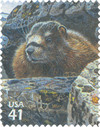
# 4198c - 2007 42c Alpine Tundra:Yellow-Bellied Marmot
U.S. #4198c
Alpine Tundra
Yellow Belly Marmot
Nature of America
Issue Date: August 28, 2007
City: Estes Park, CO
Quantity Issued: 5,000,000
Alpine tundra can be found above the tree line in high mountain areas throughout the world. The word tundra is a Lappish word meaning “land of no trees.”
Growing above 11,500 feet, the small tundra grasses, sedges, herbs, and shrubs face frigid weather and winds of more than 170 miles per hour. If damaged, tundra can take hundreds of years to recover.
Alpine tundra plants, lichens, and mosses survive long winters, blizzards, and dry, rocky soil. They grow very slowly, close to the ground. Their extensive root systems absorb scarce water and nutrients and provide anchorage against the wind. During the short summer blooming period, an abundance of showy flowers can be seen.
Many animals and birds leave the Alpine tundra in the winter. Of those that stay, some hibernate, like the marmots and ground squirrels. These animals eat large amounts of food to build up body fat before hibernation. Some small mammals, like voles, store hay in burrows and dens for winter feeding. Others, like rabbits, hunt and scavenge for food all winter.
The ninth installment of the U.S. Postal Service’s Nature of America Series shows the Alpine tundra of the Rocky Mountains during the summer season.
U.S. #4198c
Alpine Tundra
Yellow Belly Marmot
Nature of America
Issue Date: August 28, 2007
City: Estes Park, CO
Quantity Issued: 5,000,000
Alpine tundra can be found above the tree line in high mountain areas throughout the world. The word tundra is a Lappish word meaning “land of no trees.”
Growing above 11,500 feet, the small tundra grasses, sedges, herbs, and shrubs face frigid weather and winds of more than 170 miles per hour. If damaged, tundra can take hundreds of years to recover.
Alpine tundra plants, lichens, and mosses survive long winters, blizzards, and dry, rocky soil. They grow very slowly, close to the ground. Their extensive root systems absorb scarce water and nutrients and provide anchorage against the wind. During the short summer blooming period, an abundance of showy flowers can be seen.
Many animals and birds leave the Alpine tundra in the winter. Of those that stay, some hibernate, like the marmots and ground squirrels. These animals eat large amounts of food to build up body fat before hibernation. Some small mammals, like voles, store hay in burrows and dens for winter feeding. Others, like rabbits, hunt and scavenge for food all winter.
The ninth installment of the U.S. Postal Service’s Nature of America Series shows the Alpine tundra of the Rocky Mountains during the summer season.








